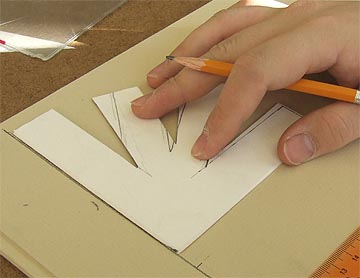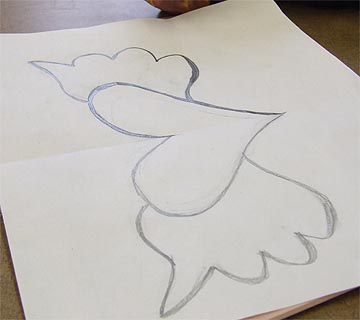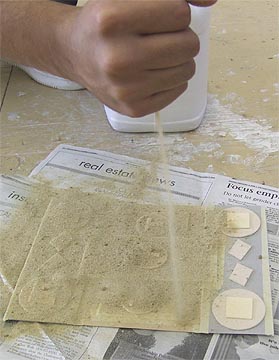Additive Process
Students were introduced to bas-relief sculptures by completing a teacher-created reading and questions sheet and by viewing pictures of ancient stone carvings. They were challenged to create a mock bas-relief "stone carving" (featuring a design of their choice) through an additive process.
They used pieces of scrap matboard for a "base" layer and formed their design from 2-4 additional layers of matboard. They were instructed to use small pieces of masking tape to close any holes or "tunnels" on the edges of the layers.
They used a couple of different methods to transfer their design to the matboard. Some students chose to make a pattern of one of the elements of their design and trace around it.

Other students used a graphite transfer method: After sketching their design, they placed their paper against a window in order to trace the design onto the back of their paper. Then, by using a pencil to darken the lines on the back of the paper, they placed their design (right side up) on a piece of matboard. As they traced over their lines on the front of the paper, the heavy application of graphite on the back side of the paper transferred to the matboard.

They used scissors and boxcutters (when necessary) to cut out their design pieces. Rough edges on the matboard were removed by sanding lightly with sandpaper.

Once they had all pieces cut out, they began arranging them and gluing the layers together.





As we began to spray these pieces (many of which were at least 9x12" in size) using simulated stone spray paint, I quickly realized that in the future I will specify that the finished pieces can be no larger than 6x6 inches. I paid approximately $7.50 per can and given the size that they worked this year, I was often only able to spray 3-5 pieces per can! (YIKES!)
Still, we were pleased with the results, especially when we saw how dramatic they looked in strong sunlight!

After sharing this project with another art teacher, she had a couple of suggestions to make this more economical. The first method involved spray painting the matboard with regular (inexpensive) paint in black or dark gray and then just spritzing on the stone fleck paint. This worked quite well and it definitely conserved the more expensive paint.
We also tried one of her other suggestions, however instead of painting the surface with regular glue, we used spray adhesive and then put sand on it. The next day the excess sand was tapped off and the piece was sprayed with regular dark paint.


So having tried this project using three different finishing techniques, a pure coating of fleck stone paint works best. If the cost is prohibitive, however, the next best method seems to be using the fleck stone paint over plain spray paint.
Bas-Relief Sculpture Gallery (Additive Process)